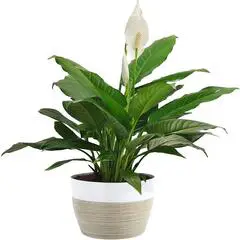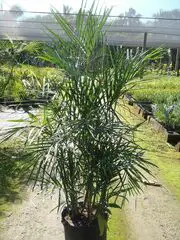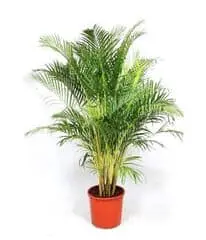If you have a green thumb, you can most likely keep indoor plants thriving and well. Anyone can benefit from having a multitude of them adorned in their homes or apartments. One thing indoor plants help with that might be under-appreciated at times is that they purify the air and produce oxygen.
Do all indoor plants purify the air and produce oxygen? Yes. They all purify the air and produce oxygen so long as the following environmental factors are maintained:
- Plenty of light is available
- Supplied fresh fertilizer regularly
- Ample nourishment is given based on species
- Air remains somewhat humid and not too dry
- There are no drafts near the plant
Basically, if you keep your plants thriving and alive, you can expect them to help purify the air and produce oxygen.
What Indoor Plants Remove The Most Pollutants?
What’s cool is NASA scientists actually studied and researched houseplants that remove the most pollutants, specifically: formaldehyde, volatile organic compounds like benzene and TCE, carbon monoxide, radon, pesticides and disinfectants, and airborne biological pollutants.
Check out the official NASA study here.
They had good reason to study these pollutants too. You see, these pesky and toxic pollutants are linked to nasty symptoms like allergies, fatigue, and headaches. What’s scary is research has also been done that possibly links these symptoms to cancer and death. The good news is, your indoor houseplants can help protect you.
These are some of the best ones to invest in:
Peace Lily (Spathiphyllum)
Peace Lilies are large-leafed indoor plants that bloom gorgeous white flowers that resemble a single petal. The peace lily actually needs very little water to thrive and it prefers to be shaded, It’s known primarily for removing contaminants such as formaldehyde, benzene, alcohols, acetone, and trichloroethylene.
While this is a great choice for an indoor plant that purifies the air, it should not be considered in a home with pets or small children, as the leaves are actually toxic when ingested. The leaves contain what is called calcium oxalate.
Boston Fern (Nephrolepis Exaltata)
The Boston Fern showed the highest ability within the tests conducted by NASA to remove formaldehyde from the air. Formaldehyde is all around us as a lot of what we use releases some amount of it into the air we breathe. Paper products, insulation, glues, and plywood, for example, all have formaldehyde. You can find these materials in every home!
This beautifully green house plant can grow up to 5 feet tall and even spread out just as wide. You’ll want to place your Boston fern in an area that provides ample room for growth. A lot of folks hang these plants in baskets. They do need a very humid environment and constantly damp soil.
Bamboo Palm (Chamaedorea Seifrizii)
The NASA study found that the Bamboo Palm scored almost as high as the Boston Fern in its ability to remove formaldehyde, while also removing pollutants such as benzene and trichloroethylene. Trichloroethylene is a very strong commercial solvent that is found in paint removers, stain removers, and adhesives.
These vibrant indoor plants resemble miniature palm trees and make a great facet in the corner of any living area. They have to be supplied with an abundance of indirect light to thrive the best, and they prefer not to be supplied with too much water. Give enough water to the bamboo palm to keep the root ball moist and provide growth.
Areca Palm (Chrysalidocarpus Lutescens)
The Areca Palm surprised scientists from NASA by removing the most Xylene and Toluene from the air. If you already know about Toluene you know it’s some pretty nasty and toxic stuff, if you don’t, Toluene is a combination of formaldehyde and dibutyl phthalate that is found in things like nail polish remover, correction fluid, and paint thinners.
Toluene has a vapor that is actually heavier than air. It is also an extreme fire hazard at room temperature. Read more about Toluene on the Agency for Toxic Substances & Disease Registry’s website.
The Areca palm can grow up to 12 feet high, and they have very thin stems which sometimes are known for toppling over. They are very vibrantly green and lush if given the proper environment for growth.
How Much Oxygen Do Plants Make?
This is one of those questions you ask yourself as you’re lying awake at night trying to count sheep. It’s a good question, and many people don’t actually know. We just assume they must produce enough oxygen, but really, is it enough? How many indoor plants do you need to effectively compensate for the oxygen you use daily?
How Much Oxygen Does a Human Need Daily
The average human will breathe in 7 to 8 liters of air per minute. Which is about 11,000 total liters every day. Now keep in mind, this is just inhaled air. The inhaled air is only going to contain about 20 percent oxygen. Weird right? Up until this point you may have thought, the air is air, and it’s all oxygen.
Air is actually made up of:
- 78.09 percent nitrogen
- 20.95 percent oxygen
- 1 percent argon
- .039 percent carbon dioxide
- .003 percent other gases
- 0-2 percent water vapor
So you just calculate your oxygen intake based on 20% right? Also wrong. You see, when you inhale air, you’re also going to exhale some of that air. Exhaled air is usually 15% oxygen. That means in total, out of the 20% oxygen you inhaled, you really only held onto 5%.
When you finally crunch the numbers, it comes out to roughly 550 liters of pure oxygen that we need to inhale each and every day.
How Much Oxygen Does an Average House Plant Produce Daily
As dismal as it may seem, while humans intake about 18-22 liters of oxygen an hour, the most common and average house plants only products 5ml of oxygen an hour. In order to produce 1 liter of oxygen an hour, you’d need at least 200 plants working together. Multiply that number by 18 or 22, and you catch my drift. Obviously, your houseplants can’t effectively keep up.
While your houseplants might not be able to replenish the oxygen you use up, it doesn’t mean they are not worth the effort to maintain. Again, they still effectively purify the air and make your living environment much more healthy.
The Mental Health Benefits of Owning Indoor Plants
On top of purifying the air quality in your home and producing some, even if it’s not enough, oxygen, they also have a positive effect on mental health.
Studies have shown that your concentration and productivity can be significantly increased (by up to 15%) simply from having indoor plants in your home. They effectively reduce stress levels and boost your mood. Researchers around the world are taking note of the mental health benefits and conducting further studies on how to best take advantage of these benefits.
By placing indoor plants in office settings, and hospital rooms, they can see how human interaction with a living plant changes or effects moods and critical thinking in these different environments that tend to be very stressful.
It’s not a bad idea to consider some indoor plants based on the above information, or maybe the next time you’re in the office you could stop by your bosses desk and tell him about the stress-reducing effect they provide, so you can better your own work environment.







Subscribe To Our Newsletter
Join our mailing list to receive news and updates. Don't worry. We will not smap you ;)
You have Successfully Subscribed!